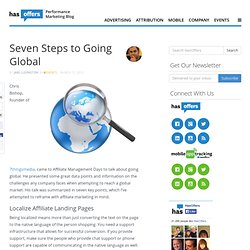

Do You Need a Global Site? As a web designer or developer, you will sooner or later meet a client that wants to expand his website’s reach by adding one or more new language to it.

Or maybe you can speak several languages and want to make your own portfolio multilingual to take advantage of your language skills. In both cases, you will soon enough discover that creating multi-languages websites is a very challenging project. The challenges of creating a more international websites are varied: they make the design process harder, maintainance more time-consuming, there can be cultural or political issues, and the website is technically more complicated. To be clear, the first question you should ask your client is: is it really worth creating a multilingual website for your business? 1. Of course, I will get much more business and make loads of cash that way!
It costs more to build With a multilingual website, everyone will have more work. It costs more to maintain It’s harder to promote 2. Language detection 3. Google Global Market Finder. Understand International Online Potential of Your Bus. The author's posts are entirely his or her own (excluding the unlikely event of hypnosis) and may not always reflect the views of Moz.

One of the major advantages of having a web-based business presence is the opportunity to reach a global audience, eliminating many of the restrictions and costs that a “physical” international presence might have. Nonetheless, from my day to day experience I’ve found that there is still a lack of vision of opportunity to target international markets. Ask yourself: when was the last time you checked how many visitors were coming to your site from other countries? Even if you have a small or mid-sized business, do you frequently check what's the percentage of your current conversions coming from other countries and languages than yours? Besides being an International SEO, I consider myself a cultural broker: I'm a Nicaraguan living in Madrid. Global perspective required for e-business. This is a guest post by venture capital investor Zach Finkelstein A decade ago, the U.S. market represented the key to consumer Internet dominance.

Now, leading consumer technology companies such as Google, eBay, and Apple have something new in common: the U.S. accounts for just a minority of their revenue. This fundamental shift in the tech sector is not surprising when one takes into account the factors driving it. According to consulting firm McKinsey, by 2015 70 percent of Internet users will live in emerging markets. At the same time, U.S. revenue models can successfully migrate overseas in sectors like commerce, banking and media. Seven Steps to Going Global. Chris Bishop, founder of 7thingsmedia, came to Affiliate Management Days to talk about going global.

He presented some great data points and information on the challenges any company faces when attempting to reach a global market. His talk was summarized in seven key points, which I’ve attempted to reframe with affiliate marketing in mind. How to go global and win big with your startup. The US is a global leader in Internet and smartphone penetration and use, but the rest of the world is catching up fast.

With a good part of the growth for consumer products happening abroad, the question isn’t if you should go global with your startup, but how and when. Europe may be a good place to start — if we combine the top 6 countries in Europe, they have a higher GDP than North America — but as you can see from the growth charts of some popular US tech companies serving international markets, a huge number of users are coming from farther afield. Above: WordPress.com Above: Tumblr. Going Global At Launch: Tips For Building A Micro-Multinational Startup. Guest author Gary Whitehill resides on the board of advisors for the Dell Center for Entrepreneurs.

In our hyper-competitive global economy, startups are just as likely to find their first customers in Paris, France, as in Paris, Texas. The barriers to international commerce continues to crumble at a dazzling pace, paving the way for the rise of what SmallBizTrend’s Anita Campbell calls the “micro-multinational.” Until recently, the designation “multinational” was reserved for giant corporations. This is no longer the case. Trend: Micro-Multinationals. 0The Council on Competitiveness has issued a study on the state of entrepreneurship in America.

One of the most fascinating parts of the report is that it identifies a trend toward something called the “micro-multinationals.” Micro-multinationals are small companies with a presence and people in multiple countries: When most people hear the phrase “multinational corporation,” they think of large, established firms with subsidiaries in major markets around the world. But a new breed of entrepreneurs is now creating “micro-multinationals” that are global from day one. Vast.com, for example, has 25 employees across five time zones, four nations and two continents. The report goes on to note that not only is a global attitude and approach the right move to find staff to grow the business, but it is seen increasingly as a prerequisite for getting venture funding: I’ve observed this trend blossoming in the past few years, particularly among technology and Internet businesses.